Financial Statement Analysis: Assessing Company Financial Position
VerifiedAdded on 2023/01/20
|13
|3236
|32
Report
AI Summary
This report provides a comprehensive analysis of financial statements, focusing on the income statement, balance sheet, and cash flow statement. It examines the components of each statement and their impact on operational decision-making. The report explores three fundamental accounting equations and two key accounting assumptions, detailing their influence on financial statement preparation. Furthermore, it employs ratio analysis, specifically liquidity and profitability ratios, to evaluate the financial performance of Example Corporation, comparing its performance to industry benchmarks. The report concludes by emphasizing the significance of financial statements for organizational success and the ongoing need for their refinement and improvement over time. This report is a valuable resource for understanding corporate financial health.
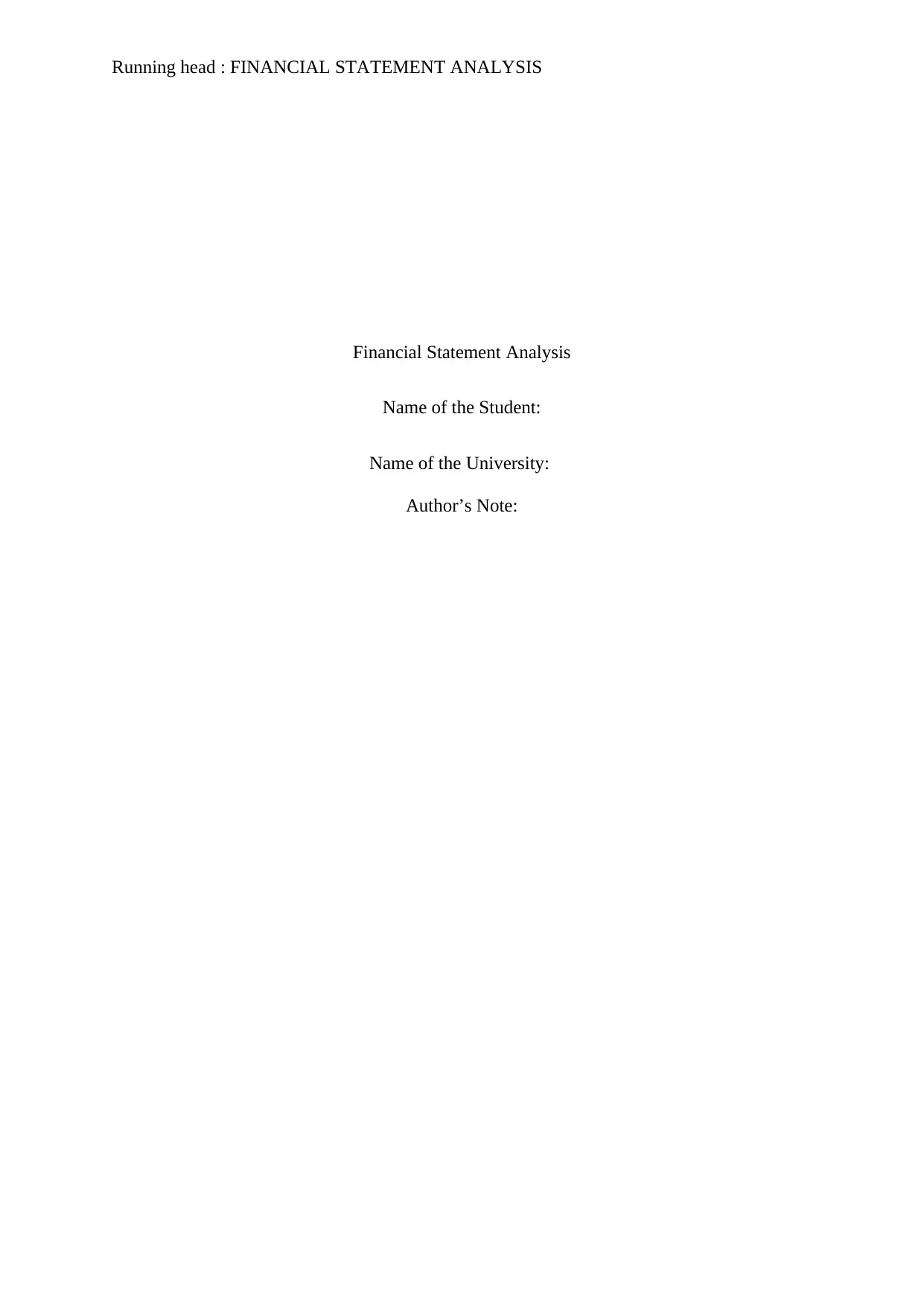
Running head : FINANCIAL STATEMENT ANALYSIS
Financial Statement Analysis
Name of the Student:
Name of the University:
Author’s Note:
Financial Statement Analysis
Name of the Student:
Name of the University:
Author’s Note:
Paraphrase This Document
Need a fresh take? Get an instant paraphrase of this document with our AI Paraphraser

1FINANCIAL STATEMENT ANALYSIS
Executive Summary:
This report aims to conduct a detailed study of three types of financial statements. It identifies
these statements and analyses the components which have an impact on the operational
decision making of the company. It also studies three basic accounting equations along with
two accounting assumptions and provides an insight into their impact on the financial
statements and their preparation. It concludes by suggesting the importance of financial
statements to the organization and the need for improving them with time.
Executive Summary:
This report aims to conduct a detailed study of three types of financial statements. It identifies
these statements and analyses the components which have an impact on the operational
decision making of the company. It also studies three basic accounting equations along with
two accounting assumptions and provides an insight into their impact on the financial
statements and their preparation. It concludes by suggesting the importance of financial
statements to the organization and the need for improving them with time.
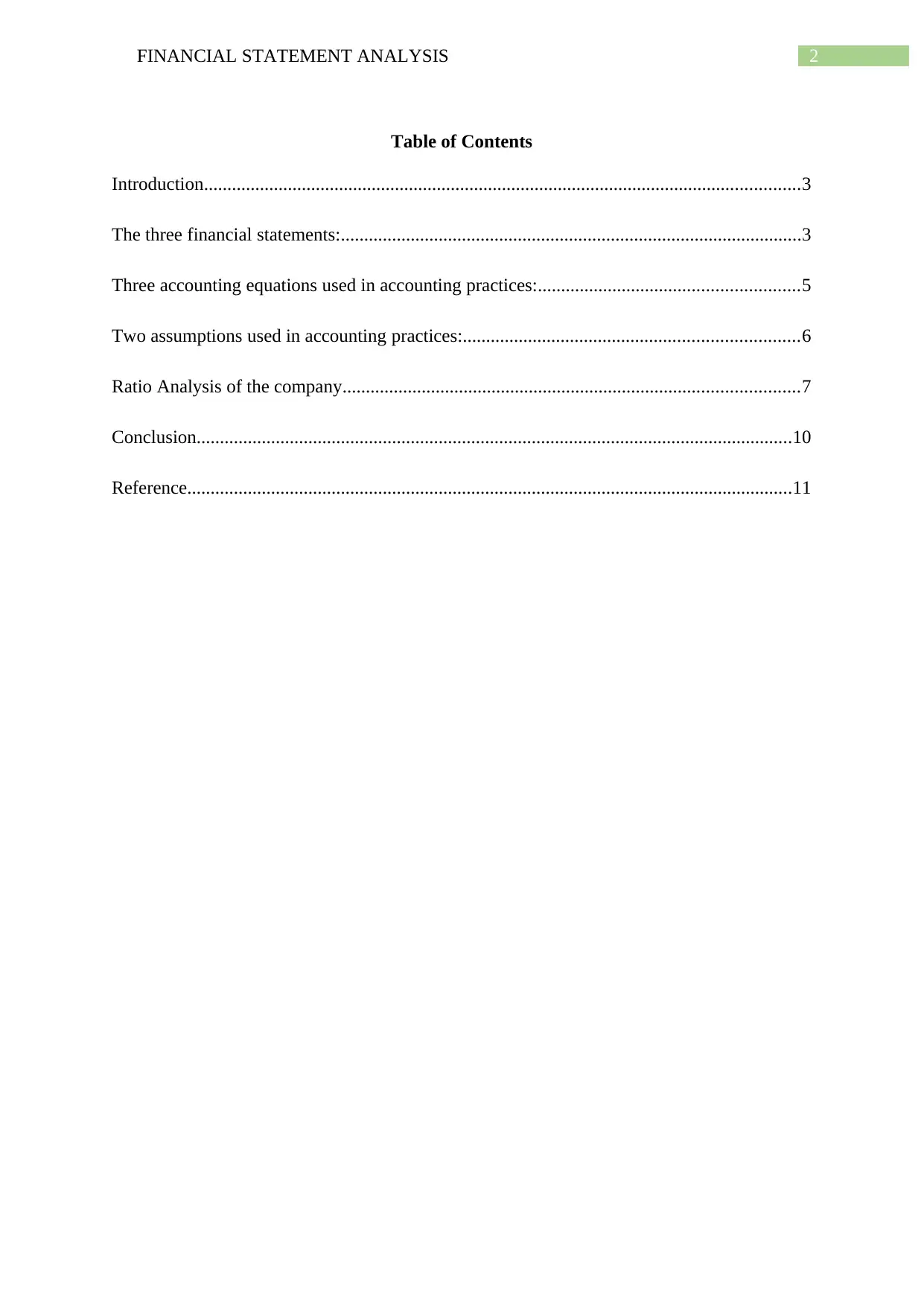
2FINANCIAL STATEMENT ANALYSIS
Table of Contents
Introduction................................................................................................................................3
The three financial statements:...................................................................................................3
Three accounting equations used in accounting practices:........................................................5
Two assumptions used in accounting practices:........................................................................6
Ratio Analysis of the company..................................................................................................7
Conclusion................................................................................................................................10
Reference..................................................................................................................................11
Table of Contents
Introduction................................................................................................................................3
The three financial statements:...................................................................................................3
Three accounting equations used in accounting practices:........................................................5
Two assumptions used in accounting practices:........................................................................6
Ratio Analysis of the company..................................................................................................7
Conclusion................................................................................................................................10
Reference..................................................................................................................................11
⊘ This is a preview!⊘
Do you want full access?
Subscribe today to unlock all pages.

Trusted by 1+ million students worldwide

3FINANCIAL STATEMENT ANALYSIS
Introduction
The report is prepared to evaluate the financial position of Example Corporation by
using the tool of ratio analysis. Assessment of the financial position is done by the
computation of ratios such as profitability and liquidity ratios. The liquidity position of
Example Corporation is evaluated by the computation of ratio such as working capital, quick
ratio, current ratio and time interest eared ratio (Minnis & Sutherland 2017). In addition to
this, the profitability position of the company is evaluated by the computation of ratios such
as gross profit margin, profit margin, earning interest per share and return on stakeholder
investment. The report also demonstrates the comparison of the values of the ratio to the
industry values along with presenting the conclusion remark on the overall performance of
company.
The three financial statements:
Three financial statements which has been taken fr a detailed analysis and discussion
are
The Income Statement
Balance Sheet
Cash Flow Statement
The Income Statement- It shows the profit or loss for a profit making organization,
and revenues and expenses for a non-profit making organization, at the end of a period ( it
can be quarterly or annually)Van Auken, H., &Carraher, S. (2013).
The components of The Income Statement are:
Revenue- It is the amount of money the organization receives mainly from sales, net
sales. It is reported at the top of the income statement.
Introduction
The report is prepared to evaluate the financial position of Example Corporation by
using the tool of ratio analysis. Assessment of the financial position is done by the
computation of ratios such as profitability and liquidity ratios. The liquidity position of
Example Corporation is evaluated by the computation of ratio such as working capital, quick
ratio, current ratio and time interest eared ratio (Minnis & Sutherland 2017). In addition to
this, the profitability position of the company is evaluated by the computation of ratios such
as gross profit margin, profit margin, earning interest per share and return on stakeholder
investment. The report also demonstrates the comparison of the values of the ratio to the
industry values along with presenting the conclusion remark on the overall performance of
company.
The three financial statements:
Three financial statements which has been taken fr a detailed analysis and discussion
are
The Income Statement
Balance Sheet
Cash Flow Statement
The Income Statement- It shows the profit or loss for a profit making organization,
and revenues and expenses for a non-profit making organization, at the end of a period ( it
can be quarterly or annually)Van Auken, H., &Carraher, S. (2013).
The components of The Income Statement are:
Revenue- It is the amount of money the organization receives mainly from sales, net
sales. It is reported at the top of the income statement.
Paraphrase This Document
Need a fresh take? Get an instant paraphrase of this document with our AI Paraphraser
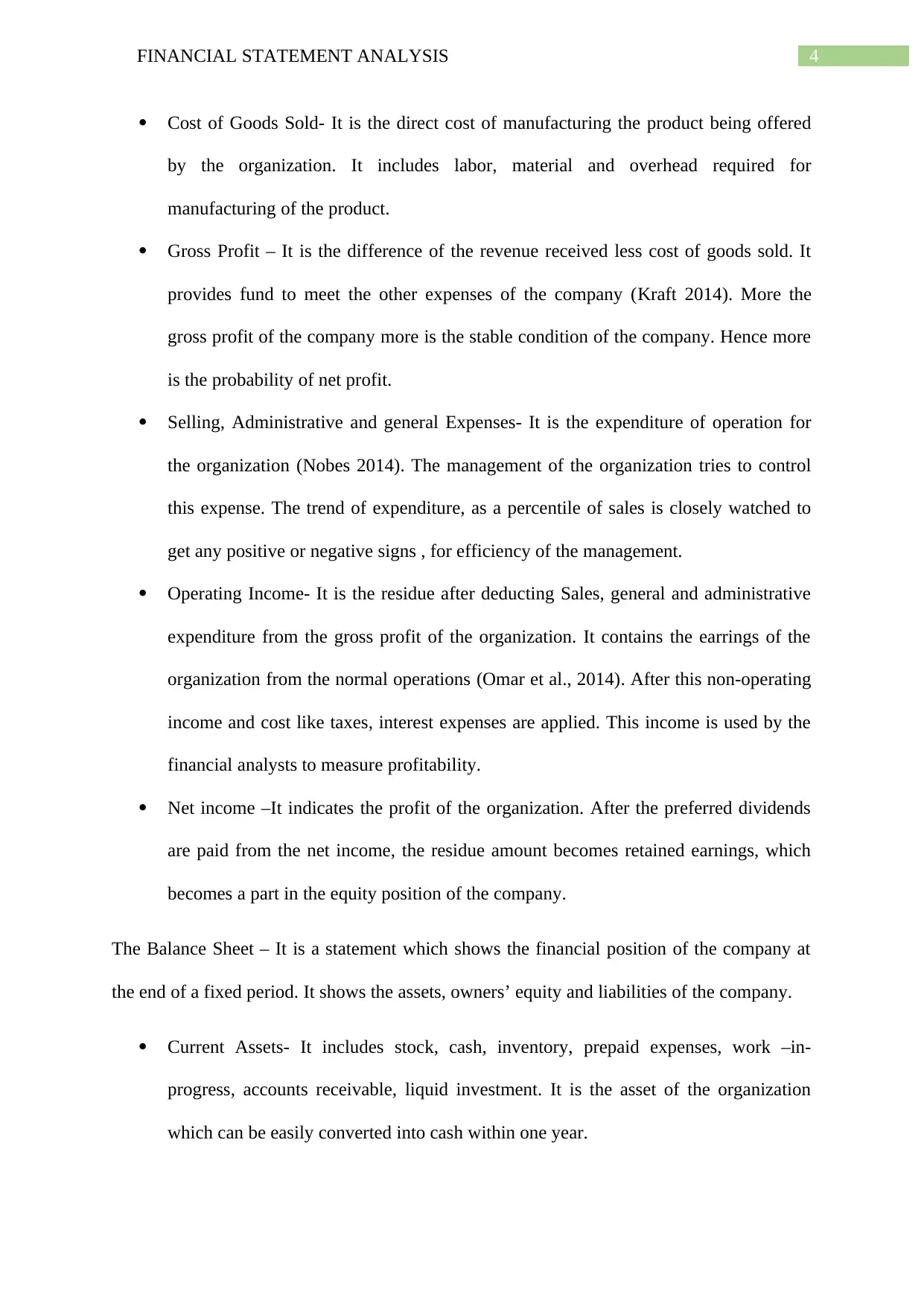
4FINANCIAL STATEMENT ANALYSIS
Cost of Goods Sold- It is the direct cost of manufacturing the product being offered
by the organization. It includes labor, material and overhead required for
manufacturing of the product.
Gross Profit – It is the difference of the revenue received less cost of goods sold. It
provides fund to meet the other expenses of the company (Kraft 2014). More the
gross profit of the company more is the stable condition of the company. Hence more
is the probability of net profit.
Selling, Administrative and general Expenses- It is the expenditure of operation for
the organization (Nobes 2014). The management of the organization tries to control
this expense. The trend of expenditure, as a percentile of sales is closely watched to
get any positive or negative signs , for efficiency of the management.
Operating Income- It is the residue after deducting Sales, general and administrative
expenditure from the gross profit of the organization. It contains the earrings of the
organization from the normal operations (Omar et al., 2014). After this non-operating
income and cost like taxes, interest expenses are applied. This income is used by the
financial analysts to measure profitability.
Net income –It indicates the profit of the organization. After the preferred dividends
are paid from the net income, the residue amount becomes retained earnings, which
becomes a part in the equity position of the company.
The Balance Sheet – It is a statement which shows the financial position of the company at
the end of a fixed period. It shows the assets, owners’ equity and liabilities of the company.
Current Assets- It includes stock, cash, inventory, prepaid expenses, work –in-
progress, accounts receivable, liquid investment. It is the asset of the organization
which can be easily converted into cash within one year.
Cost of Goods Sold- It is the direct cost of manufacturing the product being offered
by the organization. It includes labor, material and overhead required for
manufacturing of the product.
Gross Profit – It is the difference of the revenue received less cost of goods sold. It
provides fund to meet the other expenses of the company (Kraft 2014). More the
gross profit of the company more is the stable condition of the company. Hence more
is the probability of net profit.
Selling, Administrative and general Expenses- It is the expenditure of operation for
the organization (Nobes 2014). The management of the organization tries to control
this expense. The trend of expenditure, as a percentile of sales is closely watched to
get any positive or negative signs , for efficiency of the management.
Operating Income- It is the residue after deducting Sales, general and administrative
expenditure from the gross profit of the organization. It contains the earrings of the
organization from the normal operations (Omar et al., 2014). After this non-operating
income and cost like taxes, interest expenses are applied. This income is used by the
financial analysts to measure profitability.
Net income –It indicates the profit of the organization. After the preferred dividends
are paid from the net income, the residue amount becomes retained earnings, which
becomes a part in the equity position of the company.
The Balance Sheet – It is a statement which shows the financial position of the company at
the end of a fixed period. It shows the assets, owners’ equity and liabilities of the company.
Current Assets- It includes stock, cash, inventory, prepaid expenses, work –in-
progress, accounts receivable, liquid investment. It is the asset of the organization
which can be easily converted into cash within one year.
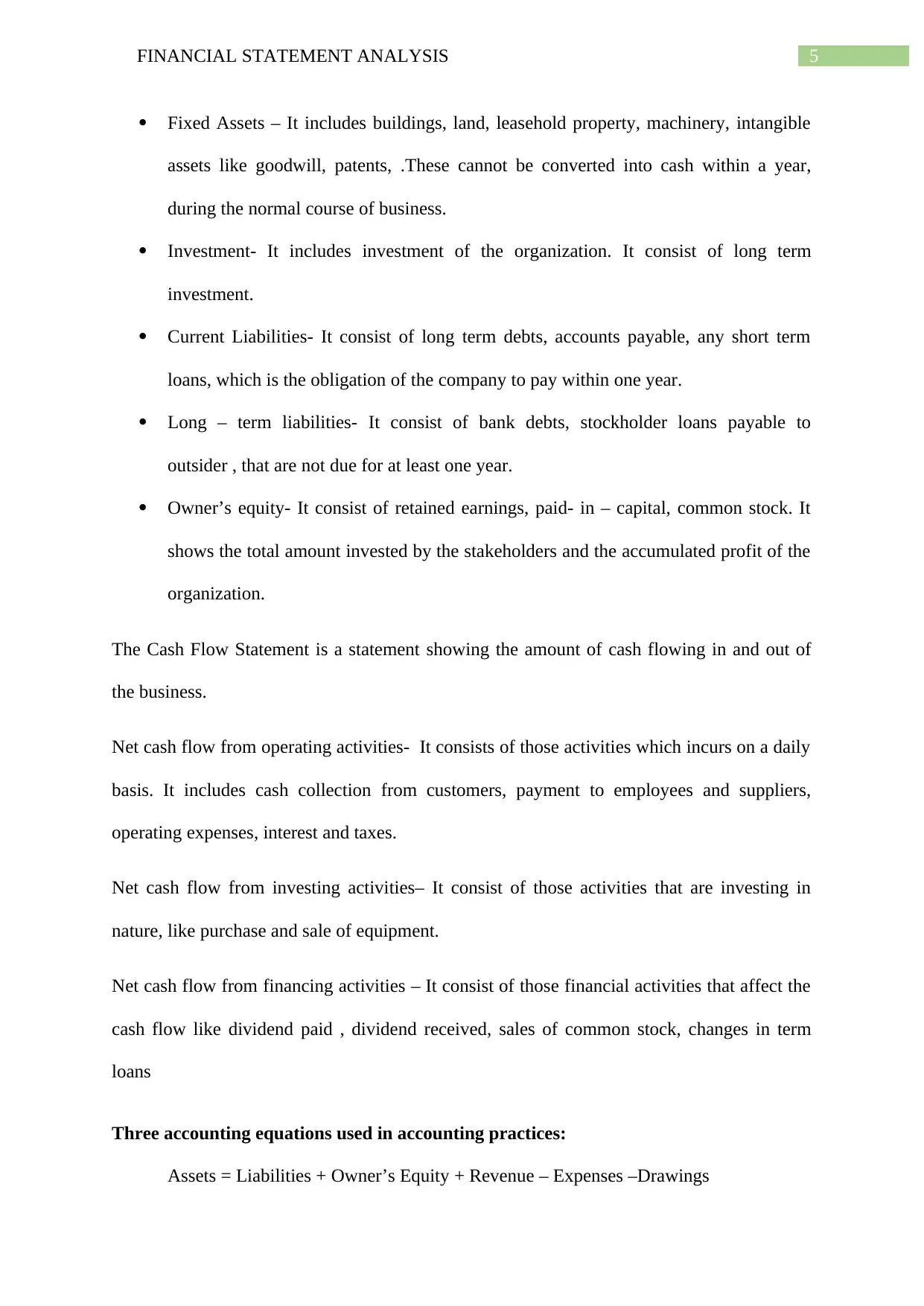
5FINANCIAL STATEMENT ANALYSIS
Fixed Assets – It includes buildings, land, leasehold property, machinery, intangible
assets like goodwill, patents, .These cannot be converted into cash within a year,
during the normal course of business.
Investment- It includes investment of the organization. It consist of long term
investment.
Current Liabilities- It consist of long term debts, accounts payable, any short term
loans, which is the obligation of the company to pay within one year.
Long – term liabilities- It consist of bank debts, stockholder loans payable to
outsider , that are not due for at least one year.
Owner’s equity- It consist of retained earnings, paid- in – capital, common stock. It
shows the total amount invested by the stakeholders and the accumulated profit of the
organization.
The Cash Flow Statement is a statement showing the amount of cash flowing in and out of
the business.
Net cash flow from operating activities- It consists of those activities which incurs on a daily
basis. It includes cash collection from customers, payment to employees and suppliers,
operating expenses, interest and taxes.
Net cash flow from investing activities– It consist of those activities that are investing in
nature, like purchase and sale of equipment.
Net cash flow from financing activities – It consist of those financial activities that affect the
cash flow like dividend paid , dividend received, sales of common stock, changes in term
loans
Three accounting equations used in accounting practices:
Assets = Liabilities + Owner’s Equity + Revenue – Expenses –Drawings
Fixed Assets – It includes buildings, land, leasehold property, machinery, intangible
assets like goodwill, patents, .These cannot be converted into cash within a year,
during the normal course of business.
Investment- It includes investment of the organization. It consist of long term
investment.
Current Liabilities- It consist of long term debts, accounts payable, any short term
loans, which is the obligation of the company to pay within one year.
Long – term liabilities- It consist of bank debts, stockholder loans payable to
outsider , that are not due for at least one year.
Owner’s equity- It consist of retained earnings, paid- in – capital, common stock. It
shows the total amount invested by the stakeholders and the accumulated profit of the
organization.
The Cash Flow Statement is a statement showing the amount of cash flowing in and out of
the business.
Net cash flow from operating activities- It consists of those activities which incurs on a daily
basis. It includes cash collection from customers, payment to employees and suppliers,
operating expenses, interest and taxes.
Net cash flow from investing activities– It consist of those activities that are investing in
nature, like purchase and sale of equipment.
Net cash flow from financing activities – It consist of those financial activities that affect the
cash flow like dividend paid , dividend received, sales of common stock, changes in term
loans
Three accounting equations used in accounting practices:
Assets = Liabilities + Owner’s Equity + Revenue – Expenses –Drawings
⊘ This is a preview!⊘
Do you want full access?
Subscribe today to unlock all pages.

Trusted by 1+ million students worldwide

6FINANCIAL STATEMENT ANALYSIS
Assets include the things that the company has like land, building cash, accounts
receivable, and inventory.
Liabilities are the obligations that the company must pay like accounts payable, loan.
Owner’s equity is that part of the company which belongs to the owner.
Net Income= Revenue- Expenses
Revenues consist of those cash flow which comes into the company as income, it can
be operating and non operating.
Expenses consist of those cost which are incurred to generate revenue.
Profit Margin =Net Income/Sales
These equations are the foundations of double entry bookkeeping system. The main
aim is to keep an eye on the debits and credits and to make sure that the sum matches the
company assets. The main reason is that every transaction should have an equivalent effect.
Two assumptions used in accounting practices:
Principle of Going Concern concept- According to this the business organization will
carry on its operations in the upcoming future and will not liquidate in the near future.
It will not be forced to discontinue its operation in near future (Zainudin & Hashim
2016). Financial Statement prepared under this is referred to as the going concern
basis of accounting.
Principle of Materiality- According to this the business organization will record only
those transactions which are relevant to the organization. Events which does not have
monetary events are not recorded. Hence full discloser is needed in financial reports.
Assets include the things that the company has like land, building cash, accounts
receivable, and inventory.
Liabilities are the obligations that the company must pay like accounts payable, loan.
Owner’s equity is that part of the company which belongs to the owner.
Net Income= Revenue- Expenses
Revenues consist of those cash flow which comes into the company as income, it can
be operating and non operating.
Expenses consist of those cost which are incurred to generate revenue.
Profit Margin =Net Income/Sales
These equations are the foundations of double entry bookkeeping system. The main
aim is to keep an eye on the debits and credits and to make sure that the sum matches the
company assets. The main reason is that every transaction should have an equivalent effect.
Two assumptions used in accounting practices:
Principle of Going Concern concept- According to this the business organization will
carry on its operations in the upcoming future and will not liquidate in the near future.
It will not be forced to discontinue its operation in near future (Zainudin & Hashim
2016). Financial Statement prepared under this is referred to as the going concern
basis of accounting.
Principle of Materiality- According to this the business organization will record only
those transactions which are relevant to the organization. Events which does not have
monetary events are not recorded. Hence full discloser is needed in financial reports.
Paraphrase This Document
Need a fresh take? Get an instant paraphrase of this document with our AI Paraphraser
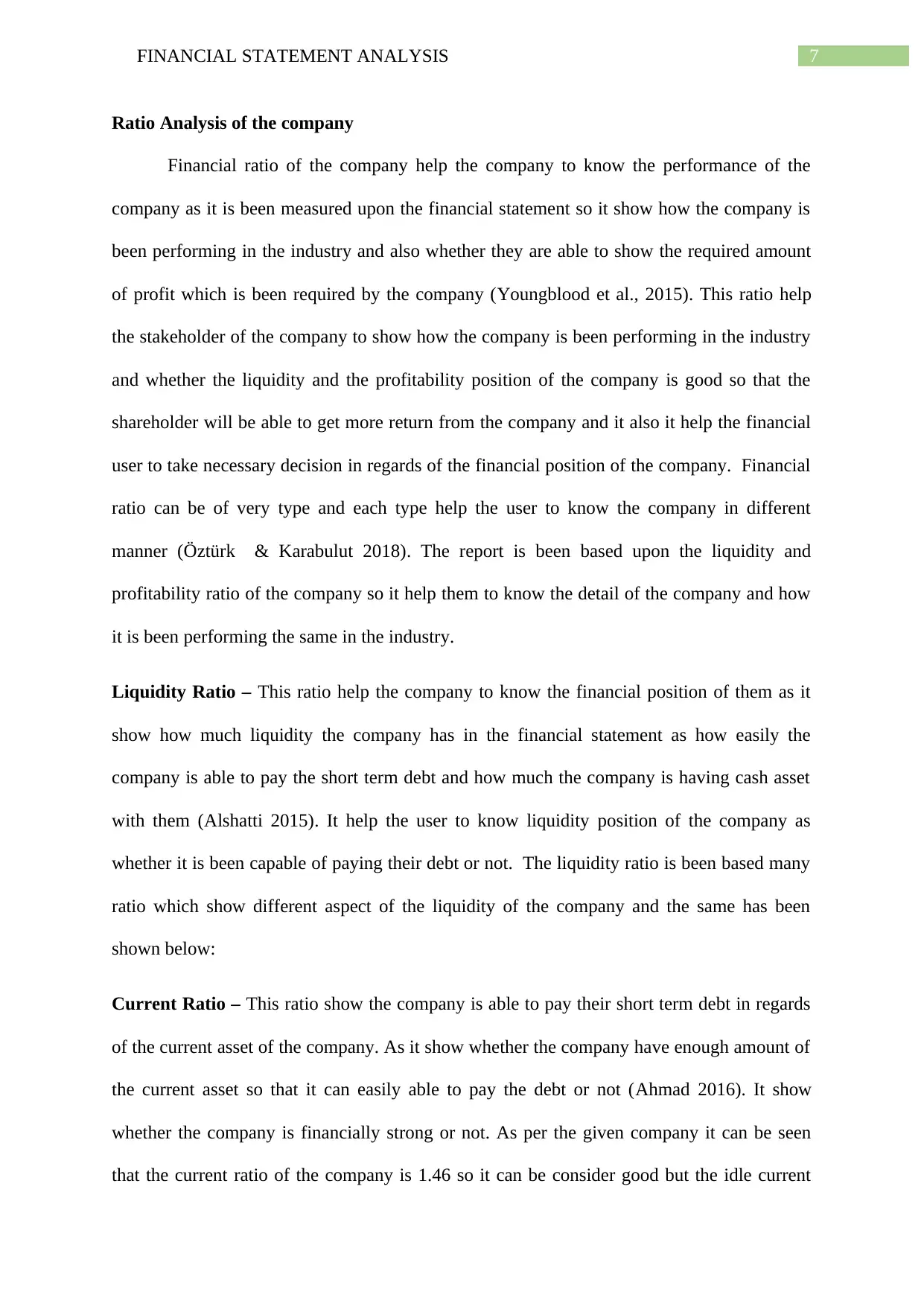
7FINANCIAL STATEMENT ANALYSIS
Ratio Analysis of the company
Financial ratio of the company help the company to know the performance of the
company as it is been measured upon the financial statement so it show how the company is
been performing in the industry and also whether they are able to show the required amount
of profit which is been required by the company (Youngblood et al., 2015). This ratio help
the stakeholder of the company to show how the company is been performing in the industry
and whether the liquidity and the profitability position of the company is good so that the
shareholder will be able to get more return from the company and it also it help the financial
user to take necessary decision in regards of the financial position of the company. Financial
ratio can be of very type and each type help the user to know the company in different
manner (Öztürk & Karabulut 2018). The report is been based upon the liquidity and
profitability ratio of the company so it help them to know the detail of the company and how
it is been performing the same in the industry.
Liquidity Ratio – This ratio help the company to know the financial position of them as it
show how much liquidity the company has in the financial statement as how easily the
company is able to pay the short term debt and how much the company is having cash asset
with them (Alshatti 2015). It help the user to know liquidity position of the company as
whether it is been capable of paying their debt or not. The liquidity ratio is been based many
ratio which show different aspect of the liquidity of the company and the same has been
shown below:
Current Ratio – This ratio show the company is able to pay their short term debt in regards
of the current asset of the company. As it show whether the company have enough amount of
the current asset so that it can easily able to pay the debt or not (Ahmad 2016). It show
whether the company is financially strong or not. As per the given company it can be seen
that the current ratio of the company is 1.46 so it can be consider good but the idle current
Ratio Analysis of the company
Financial ratio of the company help the company to know the performance of the
company as it is been measured upon the financial statement so it show how the company is
been performing in the industry and also whether they are able to show the required amount
of profit which is been required by the company (Youngblood et al., 2015). This ratio help
the stakeholder of the company to show how the company is been performing in the industry
and whether the liquidity and the profitability position of the company is good so that the
shareholder will be able to get more return from the company and it also it help the financial
user to take necessary decision in regards of the financial position of the company. Financial
ratio can be of very type and each type help the user to know the company in different
manner (Öztürk & Karabulut 2018). The report is been based upon the liquidity and
profitability ratio of the company so it help them to know the detail of the company and how
it is been performing the same in the industry.
Liquidity Ratio – This ratio help the company to know the financial position of them as it
show how much liquidity the company has in the financial statement as how easily the
company is able to pay the short term debt and how much the company is having cash asset
with them (Alshatti 2015). It help the user to know liquidity position of the company as
whether it is been capable of paying their debt or not. The liquidity ratio is been based many
ratio which show different aspect of the liquidity of the company and the same has been
shown below:
Current Ratio – This ratio show the company is able to pay their short term debt in regards
of the current asset of the company. As it show whether the company have enough amount of
the current asset so that it can easily able to pay the debt or not (Ahmad 2016). It show
whether the company is financially strong or not. As per the given company it can be seen
that the current ratio of the company is 1.46 so it can be consider good but the idle current

8FINANCIAL STATEMENT ANALYSIS
ratio is been consider as 2 so it can be said that the company need to improve their ratio so
that it can able to match the idle ratio and able to attract more amount of the investors in the
company business. So it should be ensure by the company that will work upon their current
ratio and able to make it more good in the coming years of the business.
Quick Ratio – Quick ratio is the ratio which shows the company ability to pay the short term
liability in regards of the cash asset of the company. It helps the user to know whether the
company is able to have sufficient cash asset to pay the short term debt (Ahmed 2015). The
quick ratio of the company which can be seen in case is that 1 so it can be consider as good as
the idle quick ratio is to be 1 so the company is able to manage to maintain the ratio so it is a
good option as per the investor is been considered but it can be said the company should give
emphasis upon their cash asset more so that it can able to improve the quick asset more and
able to attract more number of investors.
Time Interest Earned Ratio – This ratio help the financial user to know how the company is
sufficient to pay their interest obligation in regards of the profit which is been earned by the
company from the business (Marozva 2015). It helps the user to know that the company is
able to get the revenue so that it can able to pay their interest obligation and if the company is
not able to maintain it good it can lead it to insolvency so it is needed to be checked by the
users before taking the decision in regards of the financial statement. As per the company is
been concern it can see that the company is able to have 3.3 and as per the industry norms the
idle ratio should be 3 so it can be said that the company is having good amount of ratio as it is
having more than the industry ratio so the company is having no problem in regards of the
payment of the interest a sit able to earn enough amount of profit which can help them to pay
the interest more easily so this also help the individual user to invest in the company as it is
having a good amount of profit so the investors will able to get their money increase if they
invest in the company.
ratio is been consider as 2 so it can be said that the company need to improve their ratio so
that it can able to match the idle ratio and able to attract more amount of the investors in the
company business. So it should be ensure by the company that will work upon their current
ratio and able to make it more good in the coming years of the business.
Quick Ratio – Quick ratio is the ratio which shows the company ability to pay the short term
liability in regards of the cash asset of the company. It helps the user to know whether the
company is able to have sufficient cash asset to pay the short term debt (Ahmed 2015). The
quick ratio of the company which can be seen in case is that 1 so it can be consider as good as
the idle quick ratio is to be 1 so the company is able to manage to maintain the ratio so it is a
good option as per the investor is been considered but it can be said the company should give
emphasis upon their cash asset more so that it can able to improve the quick asset more and
able to attract more number of investors.
Time Interest Earned Ratio – This ratio help the financial user to know how the company is
sufficient to pay their interest obligation in regards of the profit which is been earned by the
company from the business (Marozva 2015). It helps the user to know that the company is
able to get the revenue so that it can able to pay their interest obligation and if the company is
not able to maintain it good it can lead it to insolvency so it is needed to be checked by the
users before taking the decision in regards of the financial statement. As per the company is
been concern it can see that the company is able to have 3.3 and as per the industry norms the
idle ratio should be 3 so it can be said that the company is having good amount of ratio as it is
having more than the industry ratio so the company is having no problem in regards of the
payment of the interest a sit able to earn enough amount of profit which can help them to pay
the interest more easily so this also help the individual user to invest in the company as it is
having a good amount of profit so the investors will able to get their money increase if they
invest in the company.
⊘ This is a preview!⊘
Do you want full access?
Subscribe today to unlock all pages.

Trusted by 1+ million students worldwide
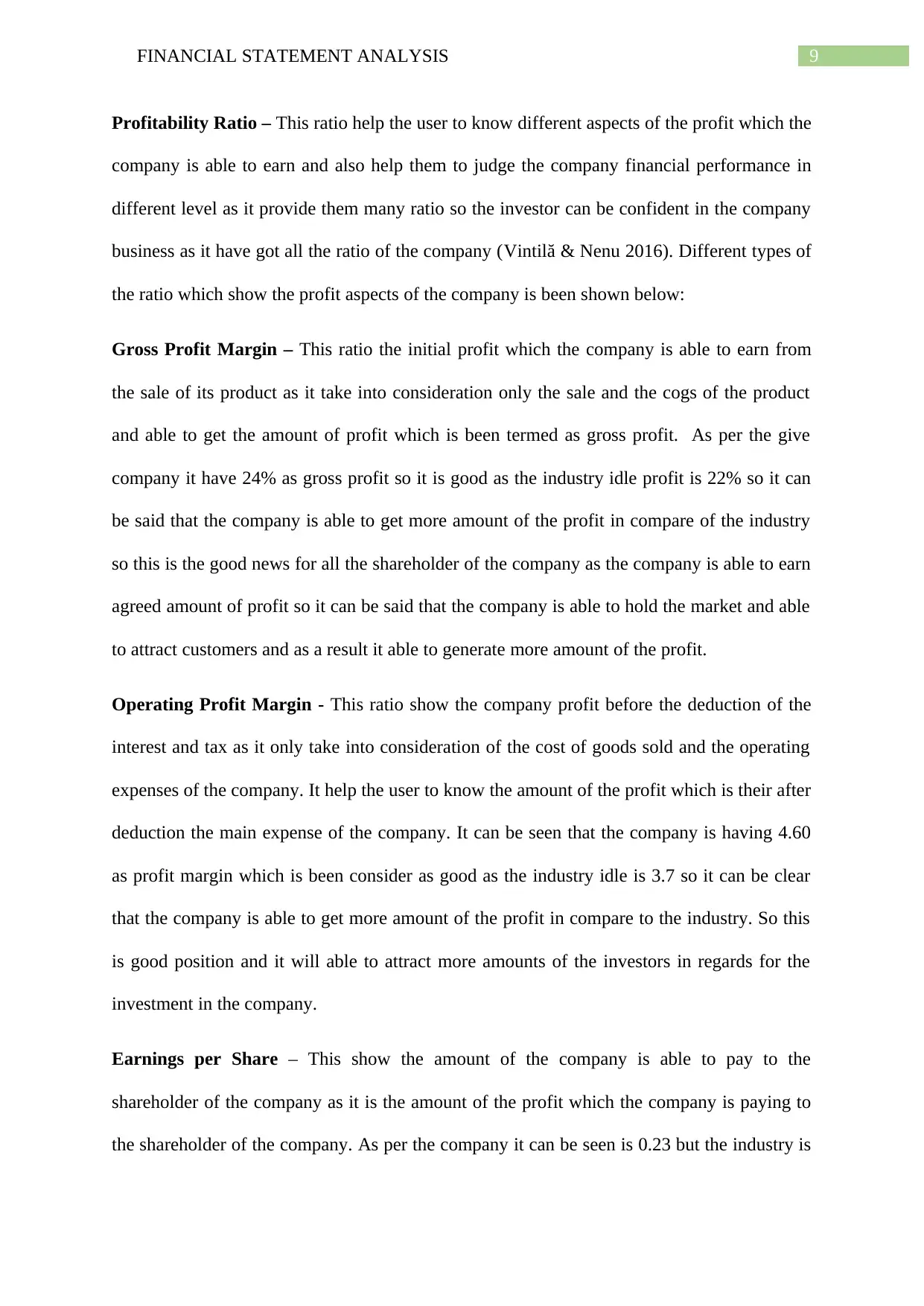
9FINANCIAL STATEMENT ANALYSIS
Profitability Ratio – This ratio help the user to know different aspects of the profit which the
company is able to earn and also help them to judge the company financial performance in
different level as it provide them many ratio so the investor can be confident in the company
business as it have got all the ratio of the company (Vintilă & Nenu 2016). Different types of
the ratio which show the profit aspects of the company is been shown below:
Gross Profit Margin – This ratio the initial profit which the company is able to earn from
the sale of its product as it take into consideration only the sale and the cogs of the product
and able to get the amount of profit which is been termed as gross profit. As per the give
company it have 24% as gross profit so it is good as the industry idle profit is 22% so it can
be said that the company is able to get more amount of the profit in compare of the industry
so this is the good news for all the shareholder of the company as the company is able to earn
agreed amount of profit so it can be said that the company is able to hold the market and able
to attract customers and as a result it able to generate more amount of the profit.
Operating Profit Margin - This ratio show the company profit before the deduction of the
interest and tax as it only take into consideration of the cost of goods sold and the operating
expenses of the company. It help the user to know the amount of the profit which is their after
deduction the main expense of the company. It can be seen that the company is having 4.60
as profit margin which is been consider as good as the industry idle is 3.7 so it can be clear
that the company is able to get more amount of the profit in compare to the industry. So this
is good position and it will able to attract more amounts of the investors in regards for the
investment in the company.
Earnings per Share – This show the amount of the company is able to pay to the
shareholder of the company as it is the amount of the profit which the company is paying to
the shareholder of the company. As per the company it can be seen is 0.23 but the industry is
Profitability Ratio – This ratio help the user to know different aspects of the profit which the
company is able to earn and also help them to judge the company financial performance in
different level as it provide them many ratio so the investor can be confident in the company
business as it have got all the ratio of the company (Vintilă & Nenu 2016). Different types of
the ratio which show the profit aspects of the company is been shown below:
Gross Profit Margin – This ratio the initial profit which the company is able to earn from
the sale of its product as it take into consideration only the sale and the cogs of the product
and able to get the amount of profit which is been termed as gross profit. As per the give
company it have 24% as gross profit so it is good as the industry idle profit is 22% so it can
be said that the company is able to get more amount of the profit in compare of the industry
so this is the good news for all the shareholder of the company as the company is able to earn
agreed amount of profit so it can be said that the company is able to hold the market and able
to attract customers and as a result it able to generate more amount of the profit.
Operating Profit Margin - This ratio show the company profit before the deduction of the
interest and tax as it only take into consideration of the cost of goods sold and the operating
expenses of the company. It help the user to know the amount of the profit which is their after
deduction the main expense of the company. It can be seen that the company is having 4.60
as profit margin which is been consider as good as the industry idle is 3.7 so it can be clear
that the company is able to get more amount of the profit in compare to the industry. So this
is good position and it will able to attract more amounts of the investors in regards for the
investment in the company.
Earnings per Share – This show the amount of the company is able to pay to the
shareholder of the company as it is the amount of the profit which the company is paying to
the shareholder of the company. As per the company it can be seen is 0.23 but the industry is
Paraphrase This Document
Need a fresh take? Get an instant paraphrase of this document with our AI Paraphraser

10FINANCIAL STATEMENT ANALYSIS
having an Earnings per Share as 0.24 so it can be said that the company is able to maintain
the industry norms properly and able to provide the profit as per the industry so it can be
conclude that it is having good amount of the business and able to get the sufficient amount
of the profit in the business.
Return on Equity – This show how the company is able to manage the asset in order to
generating the profit as it help the user to know the use of the asset by the company to get the
profit. As per the company it can be seen that the company is able to have 7.96% as return on
equity so it is good as then industry idle is 6% so it able to get more optimum utilization of
the asset as it able to generate more amount of the profit from the same.
Conclusion
It can be concluded by saying that financial statements play a major role in bridging
the gap between the management and other stakeholders of a business organization. They
also reflect the true financial position and performance of a company in most cases. However,
it cannot be denied that they suffer from their own set of limitations and hence they should be
redesigned and reinvented from time to time to overcome these limitations.
having an Earnings per Share as 0.24 so it can be said that the company is able to maintain
the industry norms properly and able to provide the profit as per the industry so it can be
conclude that it is having good amount of the business and able to get the sufficient amount
of the profit in the business.
Return on Equity – This show how the company is able to manage the asset in order to
generating the profit as it help the user to know the use of the asset by the company to get the
profit. As per the company it can be seen that the company is able to have 7.96% as return on
equity so it is good as then industry idle is 6% so it able to get more optimum utilization of
the asset as it able to generate more amount of the profit from the same.
Conclusion
It can be concluded by saying that financial statements play a major role in bridging
the gap between the management and other stakeholders of a business organization. They
also reflect the true financial position and performance of a company in most cases. However,
it cannot be denied that they suffer from their own set of limitations and hence they should be
redesigned and reinvented from time to time to overcome these limitations.

11FINANCIAL STATEMENT ANALYSIS
Reference
Ahmad, R. (2016). A Study of Relationship between Liquidity and Profitability of Standard
Charterd Bank Pakistan: Analysis of Financial Statement Approach. Global Journal
of Management And Business Research.
Ahmed, I. E. (2015). Liquidity, profitability and the dividends payout policy. World Review
of Business Research, 5(2), 73-85.
Alshatti, A. S. (2015). The effect of the liquidity management on profitability in the
Jordanian commercial banks. International Journal of Business and
Management, 10(1), 62.
Kraft, P. (2014). Rating agency adjustments to GAAP financial statements and their effect on
ratings and credit spreads. The Accounting Review, 90(2), 641-674.
Marozva, G. (2015). Liquidity and bank performance. The International Business &
Economics Research Journal (Online), 14(3), 453.
Minnis, M., & Sutherland, A. (2017). Financial statements as monitoring mechanisms:
Evidence from small commercial loans. Journal of Accounting Research, 55(1), 197-
233.
Nobes, C. (2014). International classification of financial reporting. Routledge.
Omar, N., Koya, R. K., Sanusi, Z. M., & Shafie, N. A. (2014). Financial statement fraud: A
case examination using Beneish model and ratio analysis. International Journal of
Trade, Economics and Finance, 5(2), 184.
Öztürk, H., & Karabulut, T. A. (2018). The Relationship between Earnings-to-Price, Current
Ratio, Profit Margin and Return: An Empirical Analysis on Istanbul Stock
Exchange. Accounting and Finance Research, 7(1), 109-115.
Reference
Ahmad, R. (2016). A Study of Relationship between Liquidity and Profitability of Standard
Charterd Bank Pakistan: Analysis of Financial Statement Approach. Global Journal
of Management And Business Research.
Ahmed, I. E. (2015). Liquidity, profitability and the dividends payout policy. World Review
of Business Research, 5(2), 73-85.
Alshatti, A. S. (2015). The effect of the liquidity management on profitability in the
Jordanian commercial banks. International Journal of Business and
Management, 10(1), 62.
Kraft, P. (2014). Rating agency adjustments to GAAP financial statements and their effect on
ratings and credit spreads. The Accounting Review, 90(2), 641-674.
Marozva, G. (2015). Liquidity and bank performance. The International Business &
Economics Research Journal (Online), 14(3), 453.
Minnis, M., & Sutherland, A. (2017). Financial statements as monitoring mechanisms:
Evidence from small commercial loans. Journal of Accounting Research, 55(1), 197-
233.
Nobes, C. (2014). International classification of financial reporting. Routledge.
Omar, N., Koya, R. K., Sanusi, Z. M., & Shafie, N. A. (2014). Financial statement fraud: A
case examination using Beneish model and ratio analysis. International Journal of
Trade, Economics and Finance, 5(2), 184.
Öztürk, H., & Karabulut, T. A. (2018). The Relationship between Earnings-to-Price, Current
Ratio, Profit Margin and Return: An Empirical Analysis on Istanbul Stock
Exchange. Accounting and Finance Research, 7(1), 109-115.
⊘ This is a preview!⊘
Do you want full access?
Subscribe today to unlock all pages.

Trusted by 1+ million students worldwide
1 out of 13
Related Documents
Your All-in-One AI-Powered Toolkit for Academic Success.
+13062052269
info@desklib.com
Available 24*7 on WhatsApp / Email
![[object Object]](/_next/static/media/star-bottom.7253800d.svg)
Unlock your academic potential
Copyright © 2020–2025 A2Z Services. All Rights Reserved. Developed and managed by ZUCOL.





